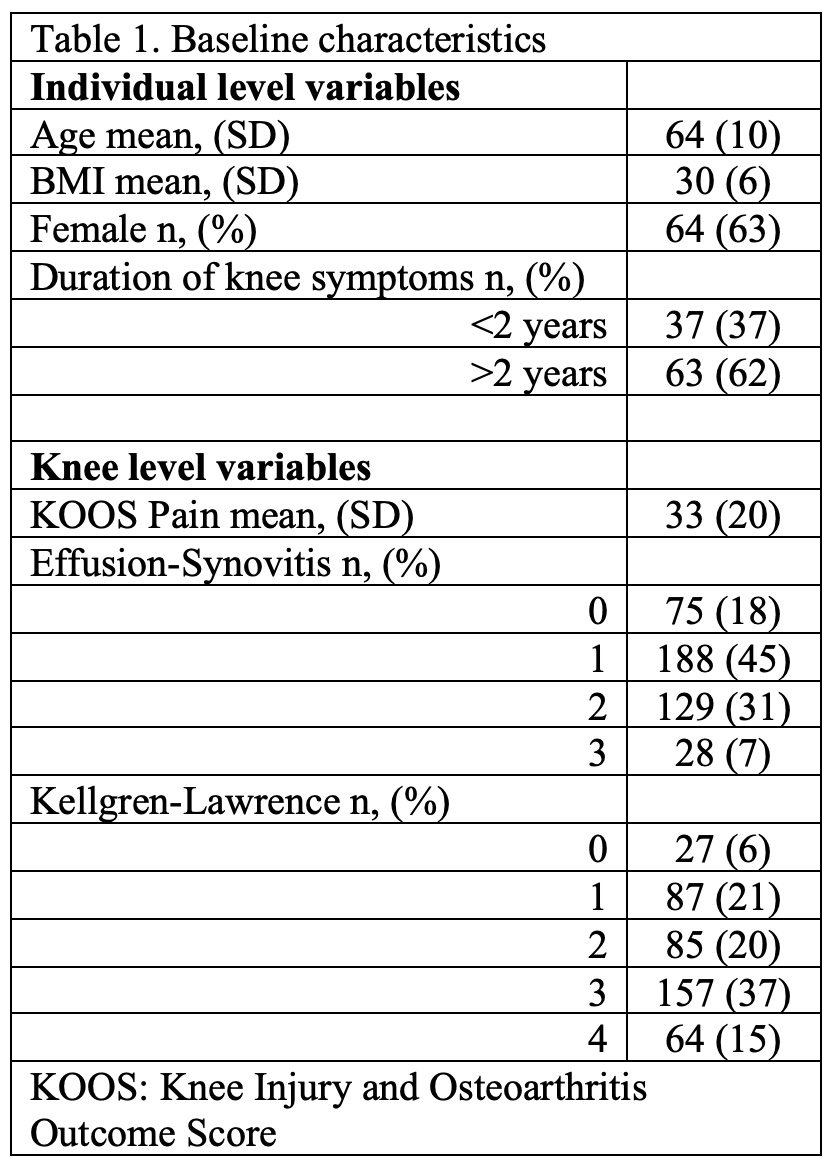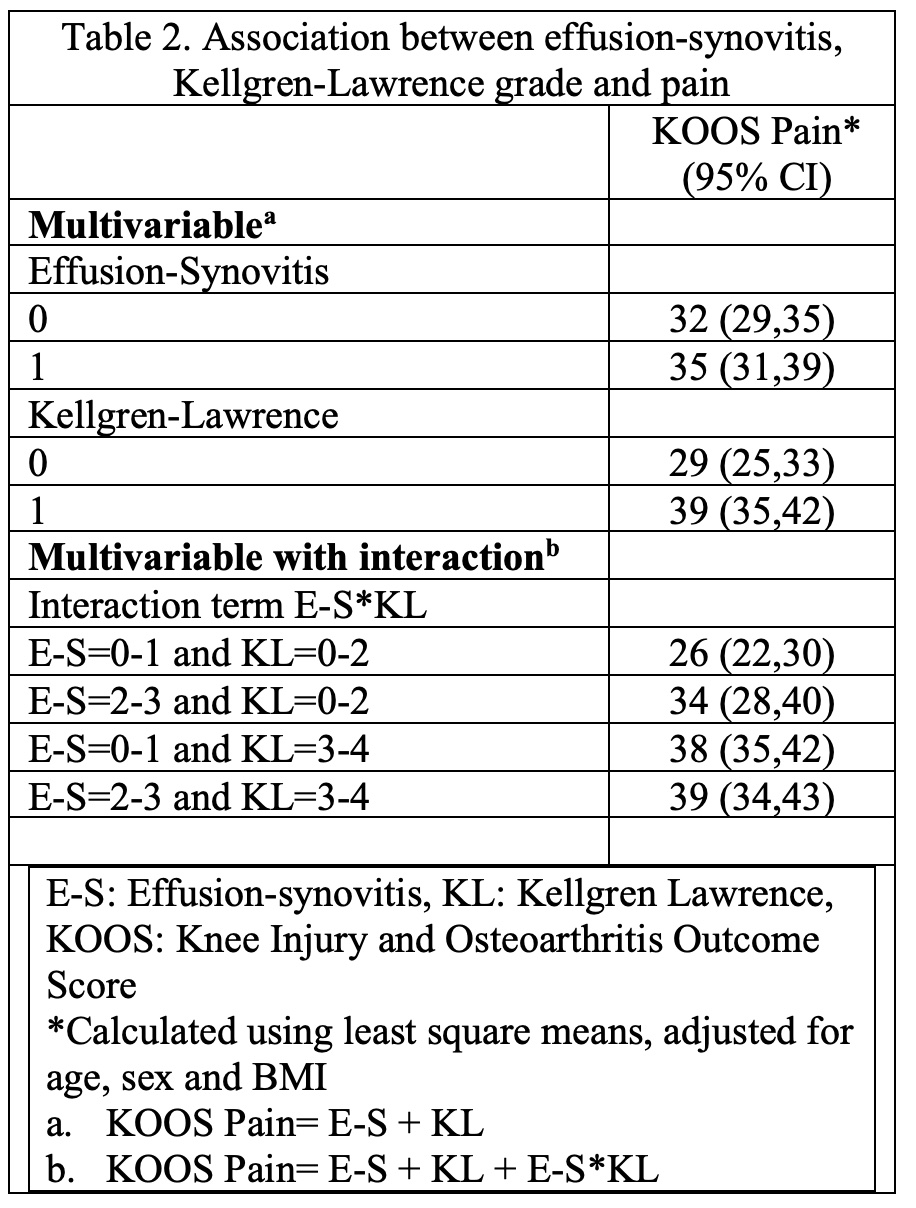Session Information
Session Type: Poster Session B
Session Time: 10:30AM-12:30PM
Background/Purpose: Pain in knee osteoarthritis (OA) is associated with structural features including effusion-synovitis (E-S) and radiographic severity. Prior studies show a cross-sectional association between larger E-S and increased pain, though this association is not always seen longitudinally. We investigated whether the association of pain and E-S varied in patients with early versus later stage knee OA.
Methods: We used data from Osteoarthritis Registry of Biomarkers and Imaging Trajectories (ORBIT), an observational cohort of 101 patients with symptomatic and radiographic knee OA. Participants underwent bilateral standing knee radiographs, and bilateral knee MRIs at baseline, 12 and 24mo. We assessed knee pain with Knee Injury and Osteoarthritis Outcome Score (KOOS) Pain score (0-100, 100 worst). Radiographs were graded according to the Kellgren-Lawrence Score (KL, 0-4). E-S was graded on MRIs according to the MRI Osteoarthritis Knee Score (MOAKS; 0-3, 3 most severe).
We considered all knees at all timepoints. We dichotomized E-S to none/small (E-S 0-1) and medium/large (E-S 2-3), and KL to early (KL 0- 2) and late stage (KL 3-4). We used linear regression with GEE (to account for clustering between knees and across timepoints) to investigate the association between KOOS Pain (dependent variable) and E-S and KL grade. We then included both E-S, KL and the interaction between E-S and KL in the same model to determine whether the effect of E-S on pain varied by KL grade. We adjusted for age, sex, and BMI.
Results: The sample included 420 knees (all participants at all timepoints with imaging data). The mean age of the cohort was 64 years (SD 10), mean BMI 30 (SD 6) and 63% were female. At baseline 37% had knee symptoms for less than 2 years.
Across all timepoints 199 (47%) knees were early KL stage and 221 (53%) late stage. None/small E-S was seen in 263 (63%) and medium/large in 57 (37%). Table 1. Individually, the least squares means (LSM) KOOS Pain score for none/small E-S was 32 and for medium/large 36 (mean difference 4 (95% CI 0.7,8)), while the LSM for early KL was 28 and late KL 39 points (mean difference 10 (95% CI 6,14; Table 2). Including both E-S and KL in the model slightly diminished the magnitude of association. The interaction between E-S and KL on pain was statistically significant (p=0.02). In patients with later stage KL the presence or absence of E-S changed pain levels by a mean difference of 0.4 (95% CI -4,4). In contrast among those in the early KL group, those with none/small E-S had a LSM of 26 for KOOS Pain while those with medium/large E-S had an LSM of 34 (mean difference 8 (95% CI 2,14); Table 2).
Conclusion: In participants with symptomatic and radiographic knee OA, the association of E-S and pain differed based on radiographic OA severity. In early-stage OA the presence of medium/large E-S was associated with a 8-point worsening in KOOS Pain, approaching a clinically important effect. In later stage (KL 3-4), the presence of E-S was associated with 0.4 point mean difference. These data raise the question as to whether anti-inflammatory treatments may be more effective in early-stage knee OA.
To cite this abstract in AMA style:
MacFarlane L, Paskewicz M, Collins J, Katz J. Association of Effusion-synovitis on Knee Pain in Early and Later-stage Knee Osteoarthritis [abstract]. Arthritis Rheumatol. 2024; 76 (suppl 9). https://acrabstracts.org/abstract/association-of-effusion-synovitis-on-knee-pain-in-early-and-later-stage-knee-osteoarthritis/. Accessed .« Back to ACR Convergence 2024
ACR Meeting Abstracts - https://acrabstracts.org/abstract/association-of-effusion-synovitis-on-knee-pain-in-early-and-later-stage-knee-osteoarthritis/


